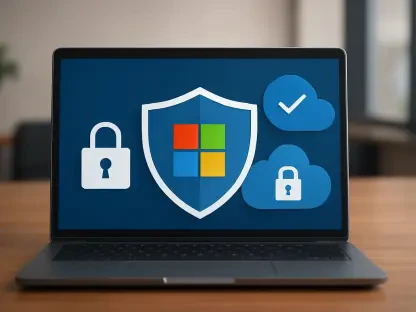Navigating the Digital Defense Line in the NFL
Imagine a scenario where a single misplaced device, like an iPad left unattended at a stadium, exposes sensitive game plans of an NFL team to the public during a critical playoff run, highlighting the very real risks in today’s digitally driven sports landscape. This isn’t a far-fetched plot but a genuine concern as the National Football League, a powerhouse of athletic competition, has embraced technology to enhance stadium operations, fan engagement, and global outreach. Yet, with this digital transformation comes an escalating array of cybersecurity threats that could jeopardize data integrity, team strategies, and fan trust. This review dives into the complex world of cybersecurity challenges faced by NFL teams, examining the vulnerabilities, emerging risks, and defensive strategies employed to protect a high-profile organization in an era of relentless cyber threats.
Unpacking the Cybersecurity Vulnerabilities in NFL Operations
Human Error: The Weakest Link in Data Security
At the heart of many cybersecurity breaches lies a surprisingly simple factor: human error. NFL teams handle vast amounts of sensitive information, from draft strategies to player health records, making any lapse a potential disaster. A notable example involved a college student accessing critical data from an unsecured device belonging to a team official, highlighting how easily personal negligence can lead to exposure. Such incidents underscore the need for robust protocols to prevent unauthorized access, especially when the stakes involve proprietary game plans that could alter competitive outcomes.
Beyond individual mistakes, the culture of rapid information sharing within teams can exacerbate risks. Coaches and staff often prioritize speed over security, sending critical details via unsecured channels or devices. This practice, while efficient in a fast-paced environment, opens doors to data leaks that could compromise entire seasons if exploited by malicious actors.
Decentralized Systems: A Sprawling Attack Surface
The operational scale of NFL teams presents another significant hurdle in maintaining cybersecurity. Teams manage a diverse array of systems, including stadium networks, ticketing platforms, and employee communications, many of which are outsourced to third-party vendors. This decentralized structure, while necessary for handling complex logistics, creates multiple entry points for cyber attackers, stretching the capabilities of often understaffed IT departments.
Compounding this issue is the inconsistency in security standards among vendors. Smaller partners may lack the resources or expertise to implement stringent safeguards, leaving gaps in the overall defense framework. For NFL teams, ensuring uniform protection across all systems remains a daunting task, especially when resources are limited and priorities are split between on-field performance and off-field security.
Emerging Cyber Threats on the NFL Horizon
The NFL’s ambitious push for global expansion introduces a new layer of cybersecurity challenges. With games scheduled in cities across Europe, South America, and beyond, teams must navigate a patchwork of data privacy regulations that vary by region. Compliance with these diverse laws, while maintaining seamless operations, demands sophisticated strategies to protect fan and organizational data from breaches during international events.
Another growing concern stems from the explosive rise of online sports betting, now a massive industry generating billions annually. This trend heightens the risk of targeted attacks aimed at manipulating game outcomes or accessing insider information for financial gain. Protecting the integrity of the sport against such threats requires innovative tools and vigilance to safeguard both digital systems and the players themselves.
Additionally, the increasing reliance on technology for fan engagement, such as biometric identification and mobile ticketing, expands the potential attack surface. While these advancements enhance the spectator experience, they also create opportunities for data theft or system disruptions, necessitating a balance between innovation and security in every digital initiative.
Case Studies: Lessons from Real-World Breaches
High-profile cyber incidents within the NFL serve as stark reminders of the stakes involved. A skimming attack on a team’s pro shop and a ransomware assault on another franchise revealed the devastating impact of inadequate defenses, resulting in financial losses and reputational damage. These events emphasize that no aspect of operations, even those managed by external partners, is immune to threats.
Focusing on a specific team, the Cleveland Browns provide a compelling case study in navigating these risks. Despite a small IT staff, their proactive measures—such as rigorous vendor vetting and continuous system monitoring—offer valuable insights into building resilience. Their experience illustrates how even resource-constrained organizations can prioritize cybersecurity to mitigate the fallout from potential breaches.
The broader implications of these incidents resonate across the league, pushing teams to reevaluate their approach to digital defense. Each breach serves as a cautionary tale, reinforcing the need for comprehensive strategies that address both internal vulnerabilities and external partnerships in an interconnected sports ecosystem.
Obstacles to Securing NFL Digital Infrastructure
One of the primary barriers to effective cybersecurity in the NFL is the constraint of resources. Many teams operate with limited IT personnel, tasked with overseeing vast digital landscapes that span multiple functions. This imbalance often leads to reactive rather than proactive measures, leaving systems exposed to evolving threats that require constant attention.
Inconsistent security standards among third-party vendors further complicate the landscape. While teams can enforce strict internal protocols, ensuring that external partners meet the same benchmarks remains a persistent challenge. This gap often results in weak links that attackers can exploit, undermining even the most robust internal defenses.
Regulatory hurdles also pose significant obstacles, particularly as teams expand internationally. Adhering to varying data protection laws across jurisdictions requires extensive legal and technical expertise, straining organizational capacities. Overcoming these challenges demands a coordinated effort to align security practices with global standards while maintaining operational efficiency.
The Future Trajectory of NFL Cybersecurity
Looking ahead, advancements in threat detection technologies hold promise for bolstering NFL defenses. Machine learning and artificial intelligence could play pivotal roles in identifying and neutralizing risks before they escalate, offering teams a proactive edge against sophisticated attacks. Integrating these tools into existing frameworks will be crucial for staying ahead of cybercriminals.
The continued globalization of the league will likely intensify cybersecurity demands, as more international games and marketing initiatives expose teams to diverse threat landscapes. Developing adaptive strategies that account for regional differences in regulations and risks will be essential to safeguard data across borders.
Ultimately, embedding cybersecurity into the strategic priorities of the NFL will determine long-term success. As digital transformation accelerates, treating cyber defense as a core component—akin to player training or game planning—will ensure that fan trust and competitive integrity remain intact amid an ever-evolving digital frontier.
Reflecting on the Digital Defense Journey
Looking back, this exploration of cybersecurity in the NFL revealed a landscape fraught with challenges, from human errors to complex decentralized systems, all amplified by global ambitions and emerging threats like online betting. The real-world incidents and case studies, particularly involving teams like the Cleveland Browns, painted a vivid picture of the high stakes and tangible impacts of breaches. Moving forward, NFL teams must prioritize investment in advanced threat detection tools and foster a culture of security awareness among staff and vendors alike. Collaborating with international regulatory bodies to streamline compliance efforts and adopting scalable solutions tailored to limited resources will be key steps in fortifying defenses. As the league continues to innovate, embedding cybersecurity as a foundational pillar will not only protect operations but also preserve the essence of the sport for future generations.









